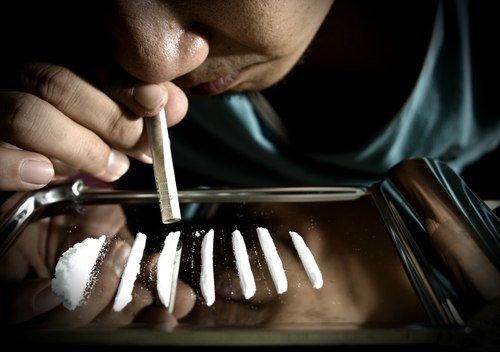What is heroin?
Heroin is an opioid drug made from morphine, a natural substance taken from the seed pod of the various opium poppy plants grown in Southeast and Southwest Asia, Mexico, and Colombia. Heroin can be a white or brown powder, or a black sticky substance known as black tar heroin. Other common names for heroin include big H, horse, hell dust, and smack. Heroin is processed from morphine, a naturally occurring substance extracted from the seed pod of certain varieties of poppy plants. The dark color associated with black tar heroin results from crude processing methods that leave behind impurities. Impure heroin is usually dissolved, diluted, and injected into veins, muscles, or under the skin.
Why Heroin Is Snorted?
Snorting involves either inhaling powdered heroin or heroin dissolved in small amounts of liquid through the nose. The drug then enters the bloodstream through the nasal tissues. It’s usually snorted by using a straw or rolled-up paper. Those who snort heroin might not feel the full initial euphoric “rush” that intravenous users do, but the ensuing effects are largely indistinguishable.
It takes about 10 to 15 minutes to feel the effects of heroin when snorted, as opposed to injecting, which can produce effects as quickly as seconds after administration. People who have allergies or congested sinuses might need more time before they feel the effects. Those who snort also carry the risk of asthma attacks, nosebleeds, breathing problems, and damage and irritation to the nasal passages, sinuses, and cartilage of the nose. People who share straws also run the risk of contracting various viral and bacterial infections from other users.
Snorting Vs. Smoking And Injecting Heroin
There is a misconception that snorting heroin is less dangerous than injecting it. No matter the method of use, heroin comes with serious health risks and significant potential for addiction. Some people believe that snorting heroin is safer because the absorption process through the nose and lungs is not as fast as smoking or injecting the drug directly into the bloodstream. Others believe that snorting heroin will keep them from becoming addicted to the drug. This is not the case, and one study finds it is actually highly likely for people who start by snorting heroin to begin injecting it as their tolerance builds.
It usually takes about five minutes to feel the effects of heroin after snorting it. With insufflation, heroin is absorbed into the nasal and throat tissues, then into the bloodstream, where it quickly makes its way through the blood-brain barrier and into the brain. In the brain, heroin reacts with opioid receptors and is chemically converted into morphine. A derivative of morphine, heroin binds to the same opioid receptors within the brain to produce euphoria, drowsiness, and altered pain perception. SEE: What Does Black Tar Heroin Look Like (Pictured)
Effects Of Snorting Heroin
The effects felt from snorting heroin will vary from person to person, depending on how much heroin was snorted, the purity of the heroin used, if a co-occurring disorder is present, and if heroin is used with another substance.
Snorting heroin for more than four weeks can lead to permanent damage to the nasal and sinus passageways. Someone who snorts heroin regularly may experience a chronic runny nose or frequent nose bleeds. Chronic heroin abuse can also lead to lung complications and possibly lung infection.
Some short-term effects of heroin abuse can include:
- the initial “rush”
- depressed respiration
- nausea and vomiting
- clouded mental processing
- suppression of pain
Potential long-term effects of heroin abuse can include:
- addiction
- bacterial infections
- abscesses (especially on the inside of the nose)
- infection of the heart lining
- arthritis
- liver and kidney disease
Heroin alters brain chemistry and, over time, damages internal organs, including the brain, liver, and kidneys.
Signs Of Heroin Snorting
Signs of heroin snorting can be more difficult to detect than other methods of abuse for heroin, but there are still many warning signs a person may display if they are snorting the drug. Typically, any heroin use will result in a persistent runny nose or sniffling due to the histamine that it releases into the body. Chronic and significant nasal irritation can be another red flag for heroin use. In some people, the nose may appear chronically red and raw-looking, and they may constantly rub or pick around the opening of the nostrils.
Even though minimal paraphernalia is used when snorting heroin, some items that may indicate this behavior can include cut straws, rolled-up pieces of paper, flat surfaces with white, powdery residue, and credit cards or other objects that could be used to create lines of the drug.
Behavioral signs that someone is abusing heroin may include changes in social life, a decline in performance at work or school, poor personal hygiene, and significant weight loss. If a person is suspected of heroin abuse, it is important to reach out for help. Due to the increased potential for addiction, heroin can cause significant, negative impacts on a person’s life. However, with proper treatment, a full recovery is possible.
How Snorting Heroin Affects Your Brain
Although snorting heroin may reduce long-term health risks associated with injecting heroin, repeatedly snorting heroin carries its own risks, such as damage to the mucosal tissues in the nose as well as perforating the nasal septum—the tissue that separates the nasal passages. Snorting heroin, however, is about half as potent when heroin is administered via intramuscular injection. It’s a noticeable difference and those who snort heroin risk switching to injecting as their drug use progresses. Overdose is another big risk that comes with snorting heroin. An overdose can occur after taking just one dose. It’s difficult for heroin users to be certain of the actual strength of what they purchase on the street, as heroin is increasingly being cut with fentanyl and other highly potent synthetic opioids. Between 2010 and 2017, the rate of heroin-related overdose deaths increased by almost 400%. Signs of overdose include extremely slow and shallow breathing, pinpoint pupils, and confusion or unconsciousness.
The Link Between Heroin Abuse And Prescription Drug Abuse
There has been a major threat posed by controlled prescription drugs (CPDs) in the U.S. since approximately 2001. According to the Centers for Disease Control and Prevention, opioids, including prescription opioids, heroin, and fentanyl, represented 63 percent of the approximate 52,000 overdoses in 2015. More recent data reflects that, in some geographical areas, the use of prescription opioids has declined. With these slightly declining levels of prescription opioid use, a corresponding increase in heroin use has been reported.
Heroin Detox And Withdrawal
Heroin is a short-acting opioid, meaning that its effects are felt quickly and it doesn’t stay in the body for long. Once someone has developed a tolerance to the drug, it is possible for them to start feeling withdrawal symptoms in as little as a few hours after their last dose. Detoxing from heroin can be an uncomfortable experience, and it is a time of increased likelihood for relapse. This is because people going through detox will often try to self-medicate in order to no longer deal with the painful withdrawal symptoms.
To minimize the chance for relapse, a medically-supervised detox program is helpful because it ensures the individual has a support system in place should they relapse. It is also possible for other, less potent opioids to be used in order to come off heroin in a safe and effective manner. These medications include methadone and buprenorphine (Suboxone, Zubsolv). Detoxing from heroin generally takes five to 10 days, depending on the severity of the addiction. The more severe the addiction, the longer the detox process will usually take.





